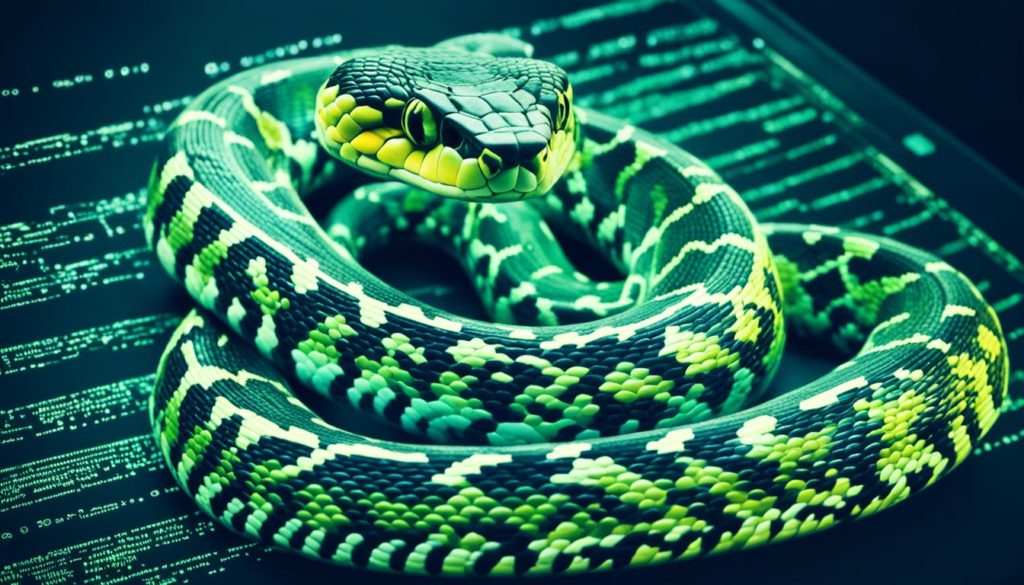
Did you know over 50% of developers use Python for server-side programming? It’s no wonder, as Python is great for web development. It’s easy to read and use, and it has powerful frameworks that big names like Spotify and Mozilla love. This makes Python perfect for creating everything from simple scripts to complex web apps.
Web development includes both front-end and back-end tasks. But Python really stands out in the back-end. It’s easy to use and clear to read, making tasks like storing data and handling web requests simpler. Python’s strong community and tools make it a top choice for building web apps that grow and work well.
Want to learn more about using Python for web development? We cover everything from setting up your environment to using frameworks like Django and Flask. Check out our detailed tutorials on Real Python to learn how to build real web solutions.
Key Takeaways
- Python’s simplicity and readability make it ideal for web development.
- It is widely used by top companies such as Spotify and Mozilla.
- Python handles server-side functionalities efficiently, including data storage and HTTP requests.
- An extensive ecosystem of libraries and frameworks supports scalable web application development.
- Resources like Django and Flask guides can help you build robust web applications.
Why Python is Ideal for Web Development
Python’s syntax is clear and easy to understand, making it great for web development. It’s perfect for both new and experienced developers. The many libraries and frameworks available make it even more appealing.
Readability and Simplicity
Python is loved for its readability and simplicity. Its syntax lets developers write and maintain code easily. This is key in big projects where clear code is a must.
With Python, teams stay productive and projects finish on time.
Large and Active Community
Python has a huge and active community. Developers share resources like documentation, libraries, and tutorials. This community helps with quick problem-solving and sharing best practices.
Extensive Libraries and Frameworks
Python has many libraries and frameworks for web development. Frameworks like Django and Flask make development easier with built-in features. They offer things like authentication, URL routing, and database connections.
This means less manual coding and more productivity. Python is great for projects of any size. It works well with databases and can handle lots of traffic, making it ideal for startups.
- Ease of Learning and Using
- Comprehensive Frameworks
- Supportive Community
Getting Started with Python for Web Development
Starting your journey into Python web development is exciting and rewarding. We’ll look at the key steps, from installing Python to setting up your environment and picking the right framework for your project.
Installing Python
The first step is to install Python. Go to the official Python website to download the latest version for your system. Make sure to follow the installation instructions carefully to set up Python correctly on your system. This is the foundation of your Python web development tools.
Setting Up a Development Environment
After installing Python, setting up a dedicated development environment is crucial. Use tools like virtualenv or venv to create isolated environments. This helps manage dependencies and prevents conflicts between projects. It makes our workflow better and keeps our projects tidy.
Choosing the Right Web Framework
Choosing the right web framework is key. For a full set of Python web development tools, Django is a great choice because of its Model-View-Controller (MVC) architecture. If you prefer a more flexible approach, Flask is ideal for smaller projects or detailed control over components.
| Aspect | Django Framework | Flask Framework |
|---|---|---|
| Architecture | MVC (Model-View-Controller) | Micro-framework |
| Flexibility | High (comes with built-in tools) | Very High (lightweight and modular) |
| Learning Curve | Moderate to Steep | Shallow |
| Best for | Large and complex applications | Small to medium applications |
Understanding these steps helps us start strong in Python web development. Whether we’re tackling big projects with Django or smaller ones with Flask, having the right tools and setup is key to success.
Exploring Popular Python Frameworks: Django and Flask
When it comes to web development using Python, Django and Flask stand out. They are both Python web frameworks that developers love for their strengths.
Django is known for its full-featured approach. It comes with many tools for web development. This includes an Object-Relational Mapper (ORM), a built-in admin interface, and strong security. Django is great for big projects needing lots of features from the start.
Flask, on the other hand, is a micro-framework. It’s simple and flexible, perfect for small projects. Developers who like to control their apps will find Flask appealing. Its design makes building apps faster and more agile.
Both Django and Flask help write clean, easy-to-maintain code. They suit different project sizes and needs. This lets developers pick the right framework for their projects.
Here’s a quick comparison to highlight some core differences:
| Feature | Django | Flask |
|---|---|---|
| Approach | Batteries-included | Micro-framework |
| Built-in Admin Panel | Yes | No |
| Flexibility | Moderate | High |
| Recommended Project Size | Large | Small to Medium |
Choosing between Django and Flask depends on your project size. Each framework has its own strengths. This lets developers pick the best one for their needs.
Building Your First Web Application with Python
Starting with Python web app development means learning the basics of web development. This includes understanding HTTP requests and data models. After setting up a good development environment and picking a framework like Flask, we can begin building our app.
We’ll create simple views and templates to show our web content. Then, we’ll add a database management system (DBMS) for storing data. Using object-relational mapping (ORM) helps us work with the database efficiently.
Handling forms and checking user input is crucial for dynamic apps. It ensures our apps work well with users. Testing and debugging are key to making our apps strong and reliable. Python’s testing frameworks are great for this.
Improving our web app as we build it is important. For more tips and a detailed guide, check out this article on Python for web development. By following best practices and using Python and Flask well, we can make web apps that are efficient and can grow with our users.
FAQ
What is Python web development?
Python web development uses the Python language for server-side tasks. It handles data storage, processes HTTP requests, and renders dynamic web content.
Why is Python a popular choice for web development?
Python is great for web development because it’s simple, easy to read, and has a strong community. This community offers many libraries and frameworks to make web projects better.
What makes Python’s syntax clear and intuitive?
Python’s syntax is clear and intuitive. It focuses on making code readable and maintainable. This lets developers write efficient code, no matter their experience level.
What are some popular Python frameworks for web development?
Django and Flask are top Python frameworks for web development. Django has many features in one package. Flask is more flexible and lets developers control their projects closely.
How do I get started with Python for web development?
Start by downloading Python from its official site and check it works with your system. Use tools like virtualenv or venv to manage your project’s dependencies. Then, pick a web framework like Django or Flask for your project.
What are the benefits of using Django for web development?
Django offers a full set of web development tools and follows the MVC pattern. It has an ORM, an admin panel, and security features. This makes Django great for big projects that need to grow.
What advantages does Flask offer for web development?
Flask is a micro-framework that’s flexible and modular. It’s perfect for small projects. Developers can build apps part by part, controlling what they use.
What should I consider when building my first web application with Python?
Know the basics of web development like HTTP requests and data models. Set up your environment and choose a framework. Start with simple views and templates. Use a DBMS for storing data and ORM for easy database work. Always test and debug your code.
What tools are essential for Python web development?
You’ll need a Python distribution, a development environment set up with virtualenv or venv, and a web framework like Django or Flask. Also, use text editors or IDEs for Python and Git for version control.
Future App Studios is an award-winning software development & outsourcing company. Our team of experts is ready to craft the solution your company needs.










